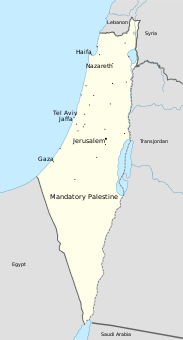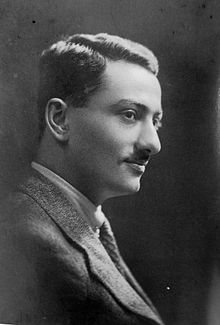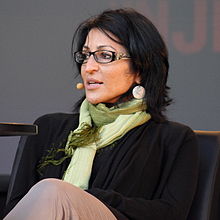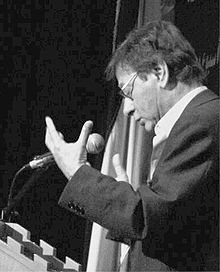Palestinians
According to British historian Perry Anderson, it is estimated that half of the population in the Palestinian territories are refugees, and that they have collectively suffered approximately US$300 billion in property losses due to Israeli confiscations, at 2008–2009 prices.
At the same time, the name Syria Palestina continued to be used by historians and geographers to refer to the area between the Mediterranean Sea and the Jordan River, as in the writings of Philo, Josephus and Pliny the Elder.
During the early 2nd century CE, Syria Palaestina became the official administrative name in a move viewed by scholars as an attempt by emperor Hadrian to disassociate Jews from the land as punishment for the Bar Kokhba revolt.
After the 1908 Young Turk Revolution, which eased press censorship laws in the Ottoman Empire, dozens of newspapers and periodicals were founded in Palestine, and the term "Palestinian" expanded in usage.
"[80][81] Historical records and later genetic studies indicate that the Palestinian people descend mostly from Ancient Levantines extending back to Bronze Age inhabitants of Levant.
[122] Some Palestinian families, notably in the Hebron and Nablus regions, claim Jewish and Samaritan ancestry respectively, preserving associated cultural customs and traditions.
[136] He notes that the archaeological strata that denote the history of Palestine – encompassing the Biblical, Roman, Byzantine, Umayyad, Abbasid, Fatimid, Crusader, Ayyubid, Mamluk and Ottoman periods – form part of the identity of the modern-day Palestinian people, as they have come to understand it over the last century.
Foster argued in a 2015 Foreign Affairs article that "based on hundreds of manuscripts, Islamic court records, books, magazines, and newspapers from the Ottoman period (1516–1918), it seems that the first Arab to use the term "Palestinian" was Farid Georges Kassab, a Beirut-based Orthodox Christian."
al-Muntada al-Adabi, dominated by the Nashashibi family, militated for the promotion of the Arabic language and culture, for the defense of Islamic values and for an independent Syria and Palestine.
Article 22 of The Covenant of the League of Nations conferred an international legal status upon the territories and people which had ceased to be under the sovereignty of the Ottoman Empire as part of a 'sacred trust of civilization'.
In 1922, the British authorities over Mandatory Palestine proposed a draft constitution that would have granted the Palestinian Arabs representation in a Legislative Council on condition that they accept the terms of the mandate.
[158] After the 1920 Nebi Musa riots, the San Remo conference and the failure of Faisal to establish the Kingdom of Greater Syria, a distinctive form of Palestinian Arab nationalism took root between April and July 1920.
[158] The Arab Higher Committee called for a nationwide general strike, non-payment of taxes, and the closure of municipal governments, and demanded an end to Jewish immigration and a ban of the sale of land to Jews.
[170] The traditional Palestinian elite who had dominated negotiations with the British and the Zionists in the Mandate, and who were largely held responsible for the loss of Palestine, were replaced by these new movements whose recruits generally came from poor to middle-class backgrounds and were often students or recent graduates of universities in Cairo, Beirut and Damascus.
A strategy more passive than that adopted by the Palestinian fedayeen, sumud provided an important subtext to the narrative of the fighters, "in symbolizing continuity and connections with the land, with peasantry and a rural way of life.
[178] In a speech to the Knesset, Deputy Premier and Foreign Minister Yigal Allon outlined the government's view that: "No one can expect us to recognize the terrorist organization called the PLO as representing the Palestinians—because it does not.
The court noted that the Israeli-Palestinian Interim Agreement on the West Bank and the Gaza Strip of 28 September 1995 also referred a number of times to the Palestinian people and its "legitimate rights".
[221] In the intervening years Israel has consistently refused to change its position and has introduced further legislation to hinder Palestinians refugees from returning and reclaiming their land and confiscated property.
Villagers would pay tribute to local patron saints at maqams – domed single rooms often placed in the shadow of an ancient carob or oak tree; many of them are rooted in Jewish, Samaritan, Christian and sometimes pagan traditions.
"[228] The concessions granted to France and other Western powers by the Ottoman Sultanate in the aftermath of the Crimean War had a significant impact on contemporary Palestinian religious cultural identity.
[234] According to Salih al-Shaykh, most Druze do not consider themselves to be Palestinian: "their Arab identity emanates in the main from the common language and their socio-cultural background, but is detached from any national political conception.
Prior to the 7th century Islamic Conquest and Arabization of the Levant, the primary languages spoken in Palestine, among the predominantly Christian and Jewish communities, were Aramaic, Greek, and Syriac.
[246] Barbara McKean Parmenter has noted that the Arabs of Palestine have been credited with the preservation of the original Semitic place names of many sites mentioned in the Bible, as was documented by the American geographer Edward Robinson in the 19th century.
[249] Claude Cheysson, France's Minister for Foreign Affairs under the first Mitterrand Presidency, held in the mid-eighties that, 'even thirty years ago, (Palestinians) probably already had the largest educated elite of all the Arab peoples.
Some common mezze dishes are hummus, tabouleh,baba ghanoush, labaneh, and zate 'u zaatar, which is the pita bread dipping of olive oil and ground thyme and sesame seeds.
Until the 1940s, a woman's economic status, whether married or single, and the town or area they were from could be deciphered by most Palestinian women by the type of cloth, colors, cut, and embroidery motifs, or lack thereof, used for the robe-like dress or "thoub" in Arabic.
[273] In a 2003 article published in Studies in the Humanities, Steven Salaita posits a fourth branch made up of English language works, particularly those written by Palestinians in the United States, which he defines as "writing rooted in diasporic countries but focused in theme and content on Palestine.
[280] Among the new generation of Palestinian writers, the work of Nathalie Handal an award-winning poet, playwright, and editor has been widely published in literary journals and magazines and has been translated into twelve languages.
Over three decades, the Palestinian National Music and Dance Troupe (El Funoun) and Mohsen Subhi have reinterpreted and rearranged traditional wedding songs such as Mish'al (1986), Marj Ibn 'Amer(1989) and Zaghareed (1997).
[291] The presence of a hand-drum in classical Palestinian music indicates a cultural esthetic conducive to the vocal, verbal and instrumental percussion which serve as the foundational elements of Hip-hop.













Boundaries defined in the 1947 UN Partition Plan for Palestine :
Armistice Demarcation Lines of 1949 ( Green Line ):

















